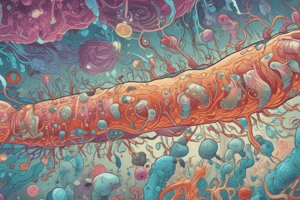Podcast
Questions and Answers
What are some examples of bacteria that have the ability to produce S layers?
What are some examples of bacteria that have the ability to produce S layers?
Clostridium difficile and Bacillus anthracis.
Explain the function of S layers in bacterial cells.
Explain the function of S layers in bacterial cells.
S layers are single layers of thousands of copies of a single protein linked together like a tiny chain-link fence. They are often called “the armor” of a bacterial cell, providing structural strength, protecting the cell from osmotic lysis, aiding in attachment, and conferring cell shape.
Describe the composition and function of bacterial glycocalyx.
Describe the composition and function of bacterial glycocalyx.
The bacterial glycocalyx is a viscous (sticky), gelatinous polymer that is external to the cell wall and composed of polysaccharide, polypeptide, or both. It aids in attachment to solid surfaces, including tissue surfaces in plant and animal hosts.
How does the chemical composition of glycocalyx vary among different bacterial species?
How does the chemical composition of glycocalyx vary among different bacterial species?
What is the role of S layers in many Archaea?
What is the role of S layers in many Archaea?
Flashcards are hidden until you start studying




